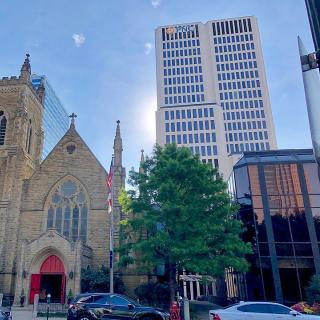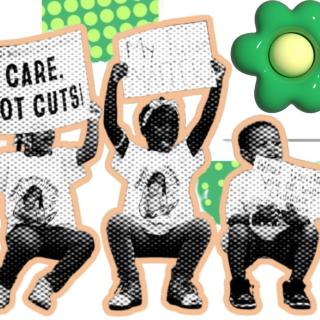The Columbus police fear the local chapter of Showing Up For Racial Justice Columbus, or SURJ Columbus. Three undercover officers were witnessed at the group’s August 19th Standing in Solidarity with Charlottesville event held at City Hall where they demanded the removal of the Christopher Columbus statue.
To SURJ Columbus, whose leadership is white, it’s downright laughable the Columbus police have to go undercover to spy on their activities. Ironically, the Columbus police could learn from SURJ because the group’s mission is a simple one: Convince white people to support black people and other minorities, and that shooting unarmed innocent minorities is not okay and convince white people Black Lives Matter is an advocacy group, not a terrorist organization.
“Ridiculous,” says SURJ Columbus director Lane Campbell about the police, who were three white guys with closed-cropped hair, wearing lame t-shirts and sporting the same wristband. “I think they were wondering if we were going to take that huge statue down.”
With the advent of Trump and especially since Charlottesville some in the mainstream media have been asking pundits: “Where did this new racism come from?” The answer is simple to SURJ Columbus. The fulcrum for the new racism is the same as the fulcrum for past racism – fear.
“I think a lot of people are feeling threatened by the racial justice work that’s being done by Black Lives Matter, for instance,” says Campbell. “There’s fear on the side of the white supremacists. In general it’s a movement based on fear. And white supremacists are coming out with a display of power and arrogance. Usually you don’t have to display your power unless your power feels threatened. And their arrogance, I think, is also a sign of fear.”
No doubt, racial fear is misappropriated fear, says William Dodson, director for the Dayspring Christian Community Development Center on the northeast side. Dodson is black and has had a front row seat to white angst towards minorities. He grew up in West Virginia where his “mining homies” thought coal jobs would return.
“Racism is the weapon of choice only because the cause of this angst and wrath is misdirected from its cause – our economic system of winners and losers,” he says. “Lost jobs due to foreign production as US auto and steel declined. Coal is dead. These emotions have been bubbling up from the abyss of low paying jobs blamed on immigrants and others.”
Dodson says the promises Trump made during the campaign – promises he almost certainly can’t keep – are just creating more racial tension.
“Trump said ‘we’ll fix it,’ but did not say how except for the wall,” he says. “My mining homies thought coal jobs would return. They didn’t realize that getting rid of Obamacare meant taking away their health benefits under the Affordable Care Act. The honeymoon is over.”
While new and old racism has the same primordial roots of fear, racists today have a new weapon in social media. Recently someone who SURJ Columbus suspects is a white nationalist or white supremacist created a copycat twitter account of SURJ Columbus. Campbell says their official account is @SURJColumbus, but out of the blue someone created @SURJCBUS.
Campbell says the tweets from the fake account say the left promotes more violence than the right. She says SURJ Columbus hasn’t given the fake account too much thought, though.
“The work that we are doing speaks for itself and it’s so much more powerful than what we are seeing from white supremacists,” she says. “Our work is rooted in a sense of love. And that’s what is going to sustain us in this movement. Not by critiquing the white nationalists and white supremacists and getting too sidetracked by responding to trolls on the internet. We want to be focusing on who wants to make a difference in this city.”
With this in mind, should racial justice movements confront white nationalists and white supremacists face-to-face at their rallies, or not show up at all?
There are multiple perspectives on the left about whether to be non-violent or to be verbally and physically confrontational, says Campbell, who says SURJ believes in non-violence. But as for confronting white supremacists non-violently she believes it’s a matter of numbers. If a few racists show up to an SURJ rally they should be ignored, she says. But at a white supremacist rally the size Charlottesville, we have to be there, she says.
“As a white activist, we need to make sure our black colleagues and people of color are not going to be harmed,” she says. “As a white person it’s important we are between any white supremacists and people of color. Because what they are saying is much more harmful to blacks, people of color and Jewish people, than it is to me. We have to let them know these white supremacists don’t speak for all of us.”



